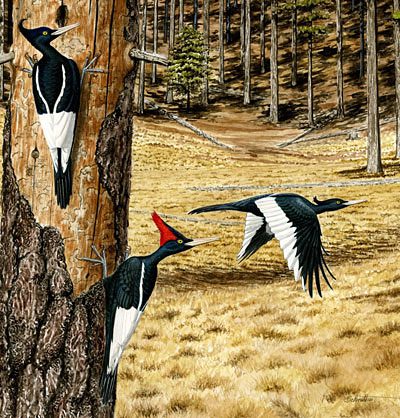See the Only Known Images of the Lost Imperial Woodpecker [Video]
By Tim Gallagher
October 26, 2011It’s not every day you get a chance to look back in time at a bird that probably no longer exists. But Cornell Lab of Ornithology scientists were able to do that with the spectacular Imperial Woodpecker of Mexico, when researcher Martjan Lammertink tracked down the only known film footage ever taken of this raven-sized woodpecker, which has not been seen alive since the 1950s.
The new issue of Living Bird magazine tells the story in detail: Martjan’s surprise discovery that the film existed, his visit to the aging filmmaker’s house, and his expeditions to Mexico’s Sierra Madre, along with article author Tim Gallagher, to try to determine whether the bird still existed. In the following excerpt of the full story, Tim Gallagher picks up the tale in 1997 as Martjan sits down with the filmmaker, William Rhein, to watch the 40-year-old film for the first time:

…Martjan had no idea what to expect of the film when he met Rhein the following morning. Perhaps it would be a blurry mess. He just hoped that the bird in the film was identifiable as an Imperial Woodpecker. As the old 16mm projector rolled noisily and the film flickered on the portable screen in Rhein’s living room, a huge woodpecker suddenly appeared, its forward-curved black crest bouncing jauntily as it hitched up a massive pine trunk. Martjan was stunned. There was no doubt about it—this was an adult female Imperial Woodpecker. The bird foraged, chipping off chunks of bark, and then flew away, but the show didn’t end there. Rhein had filmed several other short segments of the bird as she flew, foraged, and hitched up trees—sometimes in real time, other times in slow motion. This single 85-second clip held a gold mine of information about a barely studied species.

Why hadn’t Rhein told the scientific world about his Imperial Woodpecker footage? Perhaps he was embarrassed by the quality of it, which had been filmed with a hand-held movie camera from the back of a mule. Other films and still photographs he had taken always had a far more professional quality to them. Rhein said he would have a copy of the film made for Martjan, but he did not receive it until after Rhein had passed away a couple of years later.
When Martjan came to Cornell to be lead scientist of the Lab of Ornithology’s Ivory-billed Woodpecker project, he brought a DVD of the Imperial Woodpecker footage with him and played it for a group of us one afternoon. It gave me chills to see the bird—such a remarkable species, and so beautiful. Watching Rhein’s film is what ultimately inspired me to launch my own search. Here was footage of this near-mythical bird—tangible evidence of its existence taken during my lifetime—and it somehow made the quest seem more real. I soon started making forays into the high country of the Sierra Madre Occidental.
It was a different world there, almost like stepping back in time to the 19th century. The people—many of whom are Tarahumara, Tepehuan, or other indigenous groups—live mostly in adobe huts and cabins without electricity, plumbing, telephones, or other modern conveniences. They rely primarily on horses and mules to get around, which is not such a bad way to go. The mountain roads are atrocious for any kind of motor vehicle, and in many places it takes hours just to drive 30 or 40 miles….
Visit Living Bird magazine for the rest of Tim Gallagher’s story, and to see the full 85 seconds of footage, plus additional videos. The bird’s filmed movements and the team’s findings from their expedition have been summarized in the cover article in the scientific journal The Auk—you can download the article for personal use here.

All About Birds
is a free resource
Available for everyone,
funded by donors like you
American Kestrel by Blair Dudeck / Macaulay Library
